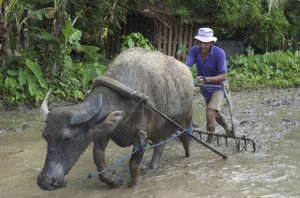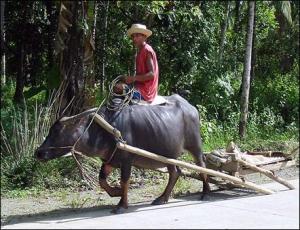The Philippine Carabao was domesticated in China were they served mainly to plough rice fields. There are a few that are still wild, but in the country, the smaller, narrower shouldered, fierce Tamaraw was an animal difficult to tame. The larger buffalo welcomed domestication, especially when raised young, and treated by children as a respected member of the family. When I was younger, I would see these water buffalos, or carabaos wading in the river, with children using their backs like diving boards. The children would mount their carabao, and reaching a certain area in the stream or river, the children would leap off their backs. During the May “Fiesta ng Mayo” festivals, carabaos would pull carts adorned with flowers, and where lovely ladies would sit or stand in beautiful costumes , during the parade of “Reyna de Helena.” Resorts in the provinces, around the rice growing regions of Baliwag-Bulacan, Bicol, near Mt. Mayon, Pagsangjan- Laguna, and Tagaytay in Cavite, are most frequented by tourists during summer season in the Philippines. Tame carabaos are a popular feature pulling tourists around in a small “kariton” or carabao cart, through rice, sugar or pineapple plantations.

TV Host, Karen Pamintuan and carabao, on her show , “LISTED” on ABS CBN, Lifestyle Channel 52, on Sky Cable .
An adult carabao has a weight close to 2,000 pounds, or about 1,000 kilos. They graze on vegetation, preferably grass near rivers where there are ponds of water that form mud puddles where these carabao love to soak on a hot day. The carabao’s skin may be tough and thick, but they do not have sweat glands. In fact, cows can be seen grazing outside in the field at high noon, whereas a carabao needs to find shade to keep itself cool. Carabao’s sensitive skins are often bitten by bugs, and leeches. A herd of buffalo are often followed by egrets and oxer birds, some riding their backs. The birds will peck off these parasites.  The carabao horns are long and black in color, and prized as much as ebony. The horns of slaughtered animals are used to make handles for serving spoons and forks. The carabao female gives birth to one to two young calves, after a ten month pregnancy. The calves that follow her everywhere until they are weaned about 6 months old. The female will then produce almost 100 kilos of milk to feed her calves that will remain with her for 2 years. Herds of water buffaloes are prized by farmers as their prime asset to use for ploughing, pulling carts full of coconuts, rice sacks, and just about any kind of produce from the fields. No gas required too! A farmer will keep a bull, and maybe three to five females for milk. The rich, creamy milk of the water buffalo is made into “kesong puti”, a local cottage cheese, or bought and churned into ice cream that was made famous by a once a premium dairy company with the brand, “Selecta.” The “pastilles de leche” are also made from carabao milk. Once the Europeans tasted this milk, they came to appreciate these animals as more than just a plough animal. In fact, several Europeans brought these carabaos to Italy, where these animals are a good producer of buffalo milk mozzarella cheese. In fact, 83,000 carabaos from the Philippines were imported to Italy. The mozzarella from these animals is preferred to that from the European cow, or African buffalo. The carabao is docile, and even affectionate to its caregiver. The meat is just as good as beef, only a bit tougher from more lean muscle, than fatty, marble laced meat from cows. The buffalo also has hair that is like that of an elephant, and is made into bracelets with tiny beads and porcelain ornaments for tourists.
The carabao horns are long and black in color, and prized as much as ebony. The horns of slaughtered animals are used to make handles for serving spoons and forks. The carabao female gives birth to one to two young calves, after a ten month pregnancy. The calves that follow her everywhere until they are weaned about 6 months old. The female will then produce almost 100 kilos of milk to feed her calves that will remain with her for 2 years. Herds of water buffaloes are prized by farmers as their prime asset to use for ploughing, pulling carts full of coconuts, rice sacks, and just about any kind of produce from the fields. No gas required too! A farmer will keep a bull, and maybe three to five females for milk. The rich, creamy milk of the water buffalo is made into “kesong puti”, a local cottage cheese, or bought and churned into ice cream that was made famous by a once a premium dairy company with the brand, “Selecta.” The “pastilles de leche” are also made from carabao milk. Once the Europeans tasted this milk, they came to appreciate these animals as more than just a plough animal. In fact, several Europeans brought these carabaos to Italy, where these animals are a good producer of buffalo milk mozzarella cheese. In fact, 83,000 carabaos from the Philippines were imported to Italy. The mozzarella from these animals is preferred to that from the European cow, or African buffalo. The carabao is docile, and even affectionate to its caregiver. The meat is just as good as beef, only a bit tougher from more lean muscle, than fatty, marble laced meat from cows. The buffalo also has hair that is like that of an elephant, and is made into bracelets with tiny beads and porcelain ornaments for tourists.  Carabaos work from dawn to dusk with the farmer ploughing fields of rice.. A farmer will keep his carabao even until these animals reach an old age. Few would sell their carabaos unless they need money very badly. If the carabao has served his master well, he will be retired and allowed to join herds of younger bulls, and females. No farmer wants to kill his carabao for meat. In fact, to insure a long life for the carabao, in most barrios, or villages, a ceremony is performed by a priest on the feast of St. Isidro, patron saint of farmers and carabaos. On that day, trained carabaos are paraded wearing garlands of flowers, and taken to the church grounds to kneel on the front legs before the priest to accept a blessing of holy water. Once blessed, the carabao may not be killed for meat, and must be considered “baptized” like a child, and loved by the farmer’s family!
Carabaos work from dawn to dusk with the farmer ploughing fields of rice.. A farmer will keep his carabao even until these animals reach an old age. Few would sell their carabaos unless they need money very badly. If the carabao has served his master well, he will be retired and allowed to join herds of younger bulls, and females. No farmer wants to kill his carabao for meat. In fact, to insure a long life for the carabao, in most barrios, or villages, a ceremony is performed by a priest on the feast of St. Isidro, patron saint of farmers and carabaos. On that day, trained carabaos are paraded wearing garlands of flowers, and taken to the church grounds to kneel on the front legs before the priest to accept a blessing of holy water. Once blessed, the carabao may not be killed for meat, and must be considered “baptized” like a child, and loved by the farmer’s family!


It’s been a long time since I’ve been to the Philippines. I do remember seeing carabaos while visiting my wife’s family in the Bicol region. There are carabaos bathing right beside little children like you described.
Fantastic blog! Very informative and well-written. Waxed nostalgic with this particular post. Spent weekends in our farm in Negros in my childhood and always loved carabaos. To a child, they were like giants but with the gentlest eyes. Didn’t know they were imported to Italy! I read somewhere that they’re endangered now. Their role as farm animals is slowly being replaced by machinery. I hope there are measures to protect them.
AJ– the carabao is such a wonderful animal–a pet, a defender of the family, work mate, giving nutritious milk and our local cottage cheese–(keso’ng puti) and there are few left being used by farmers to plough in deep mud. Most hand ploughs or gas power ploughs can’t do much in sticky mud, but the carabao loves it! farmers are fast fading as urban sprawl is enroaching into agro lands. Pity the next generation is losing appreciation for this noble beast. thanks for your feedback :0